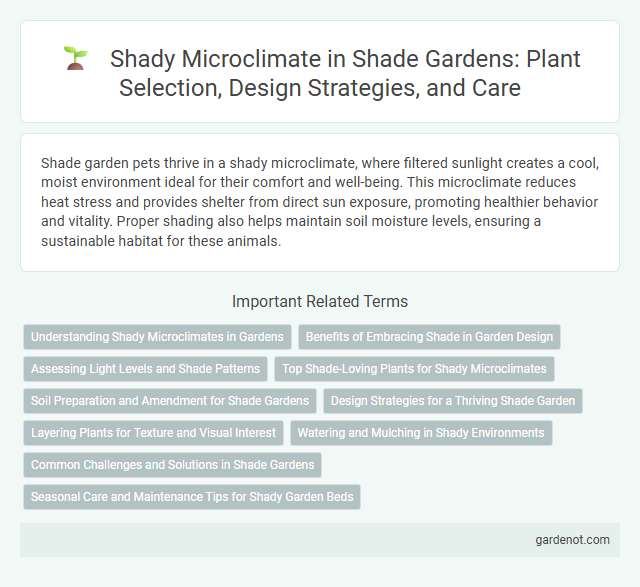Shade garden pets thrive in a shady microclimate, where filtered sunlight creates a cool, moist environment ideal for their comfort and well-being. This microclimate reduces heat stress and provides shelter from direct sun exposure, promoting healthier behavior and vitality. Proper shading also helps maintain soil moisture levels, ensuring a sustainable habitat for these animals.
Understanding Shady Microclimates in Gardens
Shady microclimates in gardens create environments with reduced sunlight, lower temperatures, and higher humidity, influencing plant selection and growth. Understanding these microclimates involves analyzing factors such as tree canopy density, structural shading, and soil moisture retention. Proper assessment ensures successful cultivation of shade-tolerant species like ferns, hostas, and astilbes that thrive in these cooler, dimmer garden niches.
Benefits of Embracing Shade in Garden Design
Embracing shade in garden design creates a cool, humid microclimate that supports diverse plant species and reduces water evaporation by up to 30%. Shade gardens promote healthier soil by minimizing heat stress and enhance biodiversity by attracting shade-loving fauna. Designing with shade improves energy efficiency, cutting cooling costs for nearby structures while offering tranquil, comfortable outdoor spaces.
Assessing Light Levels and Shade Patterns
Assessing light levels and shade patterns in a shady garden microclimate involves measuring ambient light intensity throughout the day using tools like a light meter or smartphone apps. Understanding the duration and movement of shade cast by trees, buildings, or structures helps determine the best plant placement for optimal growth. Accurate analysis of light exposure supports selecting shade-tolerant species that thrive under limited sunlight conditions in the shade garden environment.
Top Shade-Loving Plants for Shady Microclimates
Top shade-loving plants for shady microclimates include hostas, ferns, and astilbes, which thrive in low-light, cool environments. These plants excel in moisture retention and contribute to soil health while providing lush, textured foliage. Selecting native species such as hellebores and foamflowers further enhances ecosystem support and pest resistance in shaded garden zones.
Soil Preparation and Amendment for Shade Gardens
Soil preparation in shade gardens requires enhancing organic matter to improve moisture retention and nutrient availability under low-light conditions. Incorporating compost, leaf mold, and well-rotted manure boosts soil structure, supports beneficial microbial activity, and offsets the typically acidic, compacted soil found in shaded areas. Proper amendment fosters healthy root development and sustains shade-loving plants like ferns and hostas in the microclimate created by dense tree canopies or structures.
Design Strategies for a Thriving Shade Garden
Design strategies for a thriving shade garden prioritize selecting shade-tolerant plants such as hostas, ferns, and astilbes that thrive in low-light conditions and rich, well-draining soil. Incorporating layers of vegetation using ground covers, shrubs, and understory trees maximizes space and enhances biodiversity within the shady microclimate. Implementing moisture-retentive mulch and strategic planting near natural water sources supports consistent hydration and soil health in shaded garden areas.
Layering Plants for Texture and Visual Interest
Layering plants in a shade garden enhances the shady microclimate by creating diverse textures and visual interest through varied heights and foliage types. Combining understory shrubs, ferns, and groundcovers maximizes space while adding depth and richness to the garden's appearance. Strategic layering also improves moisture retention and provides habitat for beneficial insects, promoting a healthy, balanced ecosystem.
Watering and Mulching in Shady Environments
Watering in shady microclimates requires careful monitoring to avoid over-saturation, as the reduced sunlight slows soil evaporation and can lead to root rot. Applying organic mulch such as shredded bark or leaf mold helps retain soil moisture, regulates temperature, and enriches soil fertility in shaded garden areas. Consistent mulching combined with moderate watering ensures healthy plant growth by maintaining optimal moisture levels tailored to the low-light conditions of shade gardens.
Common Challenges and Solutions in Shade Gardens
Shade gardens often face challenges such as low light levels, poor air circulation, and high soil moisture, which can lead to fungal diseases and slow plant growth. To overcome these issues, selecting shade-tolerant plants like ferns, hostas, and astilbes helps ensure robust growth in low light conditions. Improving soil drainage with organic matter and pruning nearby trees to increase airflow are effective solutions for maintaining a healthy shady microclimate.
Seasonal Care and Maintenance Tips for Shady Garden Beds
Shady garden beds require specific seasonal care to thrive in low-light microclimates, emphasizing consistent moisture and soil enrichment with organic mulch to retain humidity. Spring calls for careful pruning to remove dead growth and promote air circulation, while fall demands leaf clearance to prevent fungal diseases. Winter protection with frost blankets or heavy mulch preserves root health, ensuring vibrant shade garden performance throughout the year.
Shady microclimate Infographic

 gardenot.com
gardenot.com